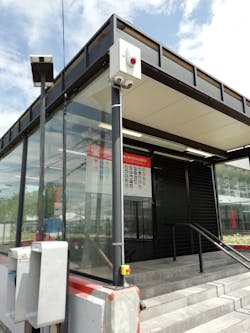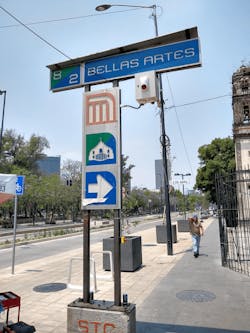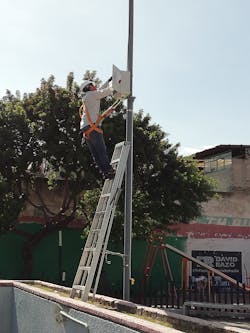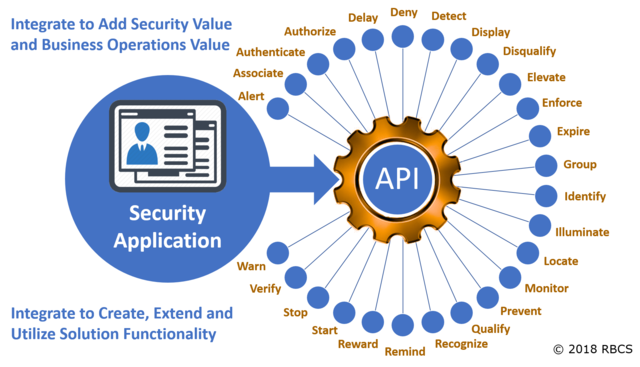This article originally appeared as the cover story in the July 2020 issue of Security Business magazine. When sharing, don’t forget to mention @SecBusinessMag on Twitter and Security Business magazine on LinkedIn.
Mexico City has a long, rich history and is known for being one of the largest financial centers on the continent, the largest Spanish-speaking city in the world, and the largest city in Latin America. About a decade ago, Mexico City authorities decided to launch its multi-year Safe City (Ciudad Segura) initiative, to improve the effectiveness of police and other emergency services.
Seven years after Safe City was launched, the official figures reflected the impact of the initiative – crime rates were down by 56%; car theft was down 58%; average response time was reduced from 12 to 2 minutes; and insurance premiums were down by 30%.
This success helped pave the way for the city’s government to expand its smart city landscape. Mexico City (Ciudad de México, abbreviated CDMX) saw the necessity to improve its communications infrastructure as a foundational part of its path to becoming a smart city. In 2016, the city began to implement a “Connectivity Master Plan for Mexico City” to increase wireless communication capabilities and Internet connectivity throughout the city, allowing it to better do business and better communicate with citizens. The city it added a new fully digital 4G LTE backbone, and launched its citizen smartphone app, App CDMX, is now available from the App Store and Google Play.
The My Street Initiative
In 2018, Mexico City elected its first female mayor, Dr. Claudia Sheinbaum, who is also the first engineer and scientist to hold that position. She holds a degree in physics, a master’s and Ph.D. in energy engineering, and is the author of more than hundred articles and two books on the topics of energy, the environment, and sustainable development. Shortly after her election, Sheinbaum an unprecedented security improvement initiative called MiCalle (My Street), which includes the installation of 58,000 new cameras over a three-year period in the 333 areas with the highest crime rate in the city and 16,000 in public passenger transport units.
“58,000 cameras are to be placed at different points in the neighborhoods with the highest crime rate,” Sheinbaum explained. “The cameras have a pole that we call a totem. The neighborhood citizen security commissions will select citizens to have a special button for these cameras [and] an audible alarm for preventive actions.”
That scale of deployment is well beyond the pace of the Safe City initiative, which averaged the installation of about 1,000 cameras per year.
Sheinbaum added that the cameras would all be connected to the city’s C5 facility, which stands for Command, Control, Computers, Communications and Citizen Contact; however, the name generally refers to the city’s Center for Emergency Attention and Citizen Protection. The city requested proposals for on-premises systems at the C5 center with fiber optic connectivity to field devices.
New Cloud-Based Approach
Omnicloud, a Mexican company specializing in cloud deployments headed by CEO Jaime Abad Valdenebro, served as the primary integrator on the first My Street project.
Abad realized that the city’s expanded communications infrastructure made it possible to take a new and vastly better approach to building out the city’s citizen protection capabilities. The company developed its own SaaS-based PSIM called OmniView, and integrated it with the cloud-based video platform from Eagle Eye Networks, enabling the immediate deployment of more than 12,000 of the vendor’s cloud-connected cameras in the city.
In the end, the My Street project serves as a shining example of the potential of the smart city vertical – in particular how a networked, cloud-based surveillance system can open up tremendous business for a security integrator and deliver safety and efficiency for a smart city.
The customer-integrator-vendor dynamics present in the Mexico City project are not always present in other cities and other types of customers; however, the principles are the same for any customer – understand what they are trying to achieve, engineer a cost-effective solution based on total value to the customer, and deliver exactly the value promised – or even a little more. Cloud-based applications are simpler to deploy, with no maintenance headaches for the integrator, and allow more flexible CapEx/OpEx funding options for their portion of the project.
Extraordinary Scale
To get an idea of the scale of the Mexico City Safe City initiative, contrast Mexico City with New York City in size and economic impact. The Mexico City metro area’s current population is 21.782 million – about 2 million more than metropolitan New York.
New York City’s metro area makes up less than 1% of the total U.S. area, yet it produces 8% of the U.S. GDP. Mexico City metro area is just over 7.5% of the country’s area and impressively produces nearly half of the national GDP. Thus, the mission of security and safety in metropolitan Mexico City amounts to protecting a large portion of the country’s economic engine.
The main economic activity in Mexico City is commerce, of which its mercados (permanent markets set in government-operated buildings) and tianguis (open-air markets that are only open on certain days of the week) are an essential part. Thus, in 2017, the city launched a pilot project through which markets were equipped with Wi-Fi connectivity, to facilitate transactions, increase business possibilities and improve the overall experience for merchants and clients.
Making the Impossible a Reality
Under the guidance of Abad, OmniCloud recommended an alternative to the fiber-optic connectivity previously used for the city’s surveillance cameras – a shift to cloud-based systems. Abad proposed using existing telecom Internet and wireless connectivity to provide a video project that would reduce the application and communications infrastructure costs by 80 to 90%. This approach would enable the city to deploy 10 to 15 times more cameras for the same cost as previous solutions, with much simpler deployments.
The city dismissed OmniCloud’s proposal – telling Abad that “it couldn’t possibly be true” that the city would get the capabilities desired for the cost and deployment schedule he offered. City officials said they had been told by others that the wireless approach to video camera connections simply would not work.
But Abad had gained much valuable experience on large-scale video projects, including a 6,000-camera deployment in Madrid and several previous sizeable security projects throughout Mexico, including another 6,000-camera deployment. He was sure that the cloud-based approach was the only realistic way to tackle an initiative of this size in a reasonable time frame and with the robustness required for an emergency response system.
Abad traveled to the Eagle Eye Networks headquarters in Austin, Texas, to meet and confer with Founder and CEO Dean Drako and President Ken Francis many times, to discuss everything from the critical role of the APIs to the logistics of a project this size to the assurance of end-to-end confidentiality, availability and integrity of system operations. Eagle Eye saw the opportunity for API and feature enhancements and involved Tijmen Vos, the company’s EMEA Technical Director, who co-founded Cameramanager, a cloud-based video surveillance platform acquired by Eagle Eye in 2017.
Abad replied to the city by offering to install five totems to prove that the proposed cost, speed and functional capabilities were indeed all genuine. True to his word, the test system was fully up and running in a matter of days, and the C5 command center and the neighborhood citizen group leaders were instantly able to exercise the functionality.
The wireless totem installations each contained a topmost enclosure that includes a Wlink R210 Industrial 4G/3G LTE IntelligentRouter connecting to the city’s C5 network, a red LED alarm light, and a pedestrian-height small yellow box with a red panic button. Two Eagle Eye 4-Megapixel indoor/outdoor cameras (model EN-CDUM-008a) record directly to an Eagle Eye Cloud Data Center.
Abad went further, pointing out that using the cloud was the only approach that could provide the fault-tolerance and performance assurance adequate for a city’s emergency response capabilities. Each totem’s Wlink R210 Intelligent 4G/3G router could fall back from 4G LTE to 3G connectivity in case of a service interruption.
The cloud video platform Abad proposed from Eagle Eye provides strong end-to-end encryption for the system’s video transmissions and storage, and ensures high system uptime through triple-redundant data storage in the cloud as well as redundant cloud computing resources. Such fault-tolerance capabilities could not be feasibly replicated within the C5 center.
Additionally, the system’s critical systems infrastructure – communications, computing and applications – would be securely maintained off-premises from the C5 center, in the hands of third-party enterprises. That provides a permanent reduction in insider-threat risk to the system, regardless of city or police personnel turnover or other potential risk-creating factors for on-premises technology, which is an important data integrity and privacy assurance factor.
Abad’s proposal and proof of concept was enough to seal the deal, and the 58,000-camera My Street initiative began with a project for 12,270 cameras, which OmniCloud managed to install in just four months – on time and within budget.
Project Challenges
Typically, in technology projects of this size, there are several showstopper issues that threaten the cost and schedule elements of the project. This project was no exception; yet, in spite of major hurdles that occurred, all goals were met. These project success elements are worth examining very closely, as the project’s four-month execution schedule seems on its face to be completely unrealistic from the start.
The initial vision of the project was to install 80% of the cameras on the walls of residential and commercial and 20% on totems;however, many citizens and businesses did not accept having the equipment mounted on their walls, insisting that totems be installed instead. There was already a city allotment for electricity reimbursement for building-mounted cameras, so the city redirected some of those funds and took on the responsibility of quickly extending electrical power to the newly designated totem locations. In the end, 80% of the cameras were installed on totems and only 20% on buildings.
OmniCloud used totem device kits containing everything needed for each totem installation, configured from the shop and pretested before going out the door for installation. Totems were working as soon as they were connected. Six highly skilled OmniCloud project managers, each with a very capable assistant, kept the project running according to plan, including the management of citizen stakeholder participation.
Part of the proposal also included leveraging OmniCloud’s proprietary PSIM system as the user interface for C5 center personnel, including for video. The company used the Eagle Eye Cloud Video API to turn the OmniView PSIM into a full solution for the My Street project.
During this process, Eagle Eye Networks identified unique opportunities to enhance the cloud API with functionality critical to a smart city. One example is the API for on-demand synchronization of video recorded on a camera to the cloud to make it available for playback by the monitoring center in a matter of seconds. Through this enhancement, not all video has to be cloud-recorded to be viewable, which allows video buffering to optimize the use of the smart city 4G network without impacting user viewing capabilities.
Key Success Factors
The first phase of the My Street project was a public-private partnership between Mexico City, neighborhood groups and OmniCloud. Abad explains that the success of the project’s first phase was made possible by running a very well-organized project, along with the following important success factors:
Purely digital 4G LTE backbone – Mexico redeployed its old 700 MHz analog TV radio spectrum for a high-performance, purely digital 4G LTE telecom network with an IP backbone. This provides 20 Mb of available bandwidth per camera, which is more than sufficient for the project’s needs.
City provisioning of endpoint power and instant testing – Mexico City provisioned electrical power to the totems for the cameras, panic buttons, red light alarm indicators and the 4G LTE routers installed on each pole. For the majority of the project, OmniCloud installed the totem posts, then the city provisioned the power points ahead of the schedule for totem device installation. This enabled device installation and activation to be accomplished in a single visit to each totem location.
Using instant cloud connectivity, the C5 center verified the receipt of video within seconds of the cameras being connected, and the endpoint and command center functionality for panic buttons and alarm annunciation were tested and verified at the moment of installation, including neighborhood representative verification and written sign-off at the totem locations.
Integrated, well-engineered cloud computing applications – OmniCloud leveraged the Eagle Eye Video API Platform – available to application developers, customers or resellers to integrate or build their own applications and solutions – to integrate video functionality into its OmniView PSIM cloud-based application. The integration of the cloud cameras and the citizen mobile app was easily performed in four weeks.
Eagle Eye’s Vos took a lead role not only in the product innovations, but also in active project support for OmniCloud. People often think of a cloud-based service as something you sign up for and get chat-based or email technical support. In this case, that support was a strong partnership that is still ongoing – and it helped enable the proof of concept test that only took a few days to plan and execute.
Top-notch subcontracted installation companies – Together, the installing companies provided a team of 200 installers, chosen“By and large the people of Mexico City are very hard workers, and that was reflected in the execution of this project,” Abad says.
Future-Proofed Both for City and Integrator
It is true that continuous delivery of cloud-based security applications, coupled with an excellent roadmap, keeps customers ever more satisfied while keeping them technologically current. It a good pairing for security systems whose end-devices have 10- to 15-year lifecycles; however, that is not just a technical future-proofing factor for end customers – it is also a revenue future-proofing factor for integrators.
Not only will the cloud approach take years off Mexico City’s deployment schedule at substantially lower cost, OmniCloud’s proposal was future-proofed for technology advancement. The 4-megapixel cameras are set to 720p resolution at 7 frames per second to respect the currently-available 4G wireless bandwidth; however, when 5G arrives, the upgraded communications will enable full resolution video transmission at likely the same telecom cost as the current 4G service.
Telecom infrastructure upgrades require no effort by the city. The current city-owned video fiber optic infrastructure does require ongoing service and would be costly to upgrade. Additionally, the city is free to change telecom providers if that means better services or costs.
The city’s 2020 security strategy includes expanding technology usage such as body worn cameras and enhanced citizen mobile app capabilities, implementation of video analytics, and expanding the video storage retention from 7 days to 30 days. Currently, there are 14,000 totems and 20,000 cameras in use, and the objective for 2020 is to achieve 49,000 operational cameras by the end of the year. Thanks to the cloud architecture, the city is able to quickly add the additional 29,000 cameras, accept video from citizen mobile phones, and add even more cameras in the following years, without having to add any server or special network infrastructure to the C5 center.
Ray Bernard, PSP CHS-III, is the principal consultant for Ray Bernard Consulting Services (www.go-rbcs.com), and is an award-winning contributor to Security Business, SecurityInfoWatch and STE magazine. He is the author of the Elsevier book Security Technology Convergence Insights, available on Amazon. Follow him on LinkedIn: www.linkedin.com/in/raybernard.










